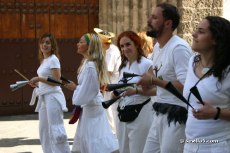
Samba is a genre of music that is not particularly prevalent within our Western society. It originates from Brazil, and is also a popular dance style, both of which have deep-seated roots in the slave-trade. Some samba stems from the drumming tradition in Brazil, from traditional regional rhythms and dances, however, it is seen as being the main musical expression from the capital of Brazil itself, Rio de Janeiro. It is particularly important within carnivals, which are major events in Brazil, where the majority of the community will turn out to join in with the live music and dancing.
The samba featuring in our modern society mostly developed at the start of the 20th century. Typically, it is in a 2/4 tempo, with alternations between sung chorus’ and verses. The chorus is often in a Batucada style, a substyle of samba, derived from African percussive style. It is very repetitive in its nature and fast paced.
The instruments in Samba vary greatly depending on the type of Samba, and whether is in the modern or traditional style. Samba used to essentially be based on the use of guitars and similar stringed instruments, along with percussion instruments like tamborims. In contemporary styles however, we see a wider range of instrumentation being employed, especially post WWII. Now we see trumpets, trombones, saxophones, clarinets, flutes and more, providing a much richer tone to the music, and enabling more layers of complimentary rhythms to be played alongside each other.
A main feature of Samba is the use of the call and response technique. This simply means that the ‘conductor’ or leader of the Samba band may play a rhythm for example, and then a select group of instruments will play either the same rhythm in return or an alternate rhythm as a contrast. This can happen at any time during the performance, so it is crucial for Samba players to always be aware of what is going on, so they know whether to play or not, or whether they need to ‘respond.’

As with other music from different continents, Samba is not usually written down with Western sheet music, or at all in fact, it very much relies on people listening and using their instruments to respond. People In a Samba band may well be taught a few different patterns or rhythms, and certain cues which correspond with each pattern, so they know when to play what, and alongside that, they must contend with the call and response section too. Often, people will be walking down the streets as part of a carnival playing this, so they have no music in front of them, or even the ability to necessarily see their conductor; it is all down to listening. As such, Samba is a very lively genre of music. There are no strict rules upon playing, nor note values as seen in Western music notation, so it is a very free and expressive genre.
Today, Samba is not really a part of our Western Culture, and only receives publicity from dance shows primarily, such as ‘Strictly Come Dancing,’ where the dance is performed, accompanied by the music itself. Hopefully, with the increasing accessibility of music through streaming and services such as youtube, Samba will attain more attention from a wider range of people across the globe, as we discover new music from a diverse range of other cultures and incorporate it into our own daily lives.
http://www.normans.co.uk/blog/2014/07/world-drums-samba-drums/
https://www.sevilla5.com/activities/goingout/samba-music-parade.html

0 Comment:
Be the first one to comment on this article.